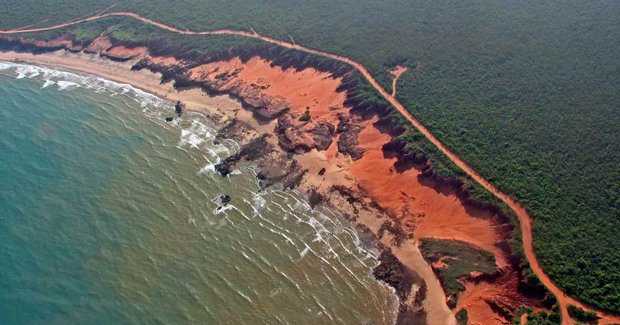Traditional owners voice James Price Point concerns

AS NAIDOC WEEK DREW to a close, traditional owners from Broome travelled to Redfern in Sydney on Saturday to voice their concerns about the proposed $30 billion liquefied natural gas (LNG) project at James Price Point. They say turning their coast into a gas hub will have devastating impacts on wildlife and nearby communities.
Neil Mackenzie, a traditional owner from Broome and co-chair of the Save the Kimberley group, told an audience at Redfern’s community centre that he’s worried the project will destroy local culture and livelihoods. “It is almost the last outback wilderness area in the world. What we have there is very precious,” he said. “There are a lot of communities out there that depend on ecotourism and keeping the country the way it is,” he says.
The LNG project from company Woodside would include building eight pipelines to the shore at James Price Point, a 2km jetty, a construction camp to house 8000 workers, as well as clearing 2500 hectares of coastal bushland. Over the past month, anti-gas hub protestors have blockaded the proposed site, about 60km from Broome, to stop Woodside carrying out geotechnical studies. So far at least 25 arrests have been made.
Alternatives for the Kimberley
Glen Klatovsky, Kimberley campaigner for The Wilderness Society says instead of building a gas-processing plant at James Price Point, the company should pipe the gas to the Pilbara, south of the Kimberley, because it already has gas-processing infrastructure. “We’re not saying no to gas,” he says. “We’re saying this is the wrong site.”
The Wilderness Society also supports a floating LNG gas hub offshore, which would allow gas to be extracted, processed, and then loaded onto ships at sea. This option has already been flagged by Shell as a preferred gas-processing option for its projects in the Browse Basin, offshore north of Broome.
The WA Government moved to compulsorily acquire the land at James Price Point late last year, and in May 2011, traditional elders voted 60-40 in favour of building a gas hub on the site. If the project goes ahead local Aboriginal people will be compensated $1.5 billion from Woodside. But Kerrianne Cox, a traditional owner from Beagle Bay on the Dampier Peninsula, says the vote wasn’t transparent. “I do not believe that our land councils are there to represent us. The slice of the pie that we got is very small,” she says.
The project has the support of the WA Premier Colin Barnett, and federal environment Minister Tony Burke is still weighing up the potential environmental impacts before he makes a decision.
Pristine Beauty
Glen hopes the minister will be tough when going through the environmental impact assessments. “You
can’t build something of that scale and not have a negative impact on
the community,” he says. “There’s something like seven or eight thousand
pages in strategic assessment reports, and over 10,000 submissions, so
there’s scope for how interventionist he will be with this.”
The Kimberly region of North West Australia makes up an area as large as California and three times the size of England.
Broome’s coast is home to the world’s largest Humpback whale nursery, five species of turtle, dugong, coral reefs and snubfin dolphin. As well as 40,000-year-old rock paintings, there are fossilised footprints of 15 types of dinosaur that span the coast where the plant would be built.
RELATED STORIES

